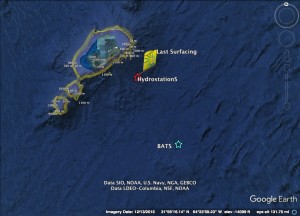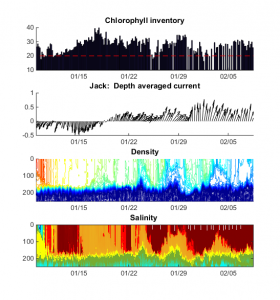“Jack” has been profiling the water column at Hydrostation S since early January. From February to June 2017, all three gliders will be used to conduct intensive sampling as part of continued efforts to understand plankton production and the “Spring Bloom” in the Sargasso Sea. Last year the gliders “Anna” and “Minnie” together measured events in which plumes of nutrient-rich waters were pumped up into the sunlit layers from below, spurring bursts of phytoplankton production measured as sharp increases in chlorophyll and oxygen concentrations. The episodes were associated with strong winds interacting with ocean currents and watermass properties, and occur on timescales of a few days. The gliders’ ability to sample continuously over the span of several months enables them to record the details of these processes and the conditions under which they occur – extremely important for understanding carbon and nutrient cycling in the ocean and their roles in supporting marine ecosystems and the biological carbon pump.
Two gliders, Anna and Minnie, will profile continuously at 2 sites – Hydrostation S and BATS – separated by ~40 miles, while Jack will run back and forth between them acquiring a cross section of the ocean every 5 days. This configuration will reveal the presence of fronts and ocean eddies, and how these features influence phytoplankton production through interactions with winds.
- Locations of Hydrostation S and BATS offshore of Bermuda
- Jack’s measurements this winter already reveal episodes in which dense, nutrient-laden plumes are pumped up to shallow, sunlit layers from below. This has resulted in increased chlorophyll concentrations (an indicator of phytoplankton abundance) a few days later. Jack does not carry a nutrient sensor, but salinity can also be used to trace the pumping action.



